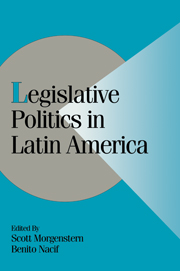Book contents
- Frontmatter
- Contents
- Tables and Figures
- Contributors
- Preface and Acknowledgments
- Party Names and Other Acronyms and Abbreviations
- 1 TOWARDS A MODEL OF LATIN AMERICAN LEGISLATURES
- Part I Executive–Legislative Relations
- 2 OSCILLATING RELATIONS: PRESIDENT AND CONGRESS IN ARGENTINA
- 3 PRESIDENTIAL CABINETS, ELECTORAL CYCLES, AND COALITION DISCIPLINE IN BRAZIL
- 4 EXAGGERATED PRESIDENTIALISM AND MODERATE PRESIDENTS: EXECUTIVE–LEGISLATIVE RELATIONS IN CHILE
- 5 EXECUTIVE–LEGISLATIVE RELATIONS: THE CASE OF MEXICO (1946–1997)
- Part II Political Parties and Legislative Structure
- Part III Legislatures and the Policy Process
- Part IV Conclusions
- References
- Author Index
- General Index
5 - EXECUTIVE–LEGISLATIVE RELATIONS: THE CASE OF MEXICO (1946–1997)
Published online by Cambridge University Press: 14 January 2010
- Frontmatter
- Contents
- Tables and Figures
- Contributors
- Preface and Acknowledgments
- Party Names and Other Acronyms and Abbreviations
- 1 TOWARDS A MODEL OF LATIN AMERICAN LEGISLATURES
- Part I Executive–Legislative Relations
- 2 OSCILLATING RELATIONS: PRESIDENT AND CONGRESS IN ARGENTINA
- 3 PRESIDENTIAL CABINETS, ELECTORAL CYCLES, AND COALITION DISCIPLINE IN BRAZIL
- 4 EXAGGERATED PRESIDENTIALISM AND MODERATE PRESIDENTS: EXECUTIVE–LEGISLATIVE RELATIONS IN CHILE
- 5 EXECUTIVE–LEGISLATIVE RELATIONS: THE CASE OF MEXICO (1946–1997)
- Part II Political Parties and Legislative Structure
- Part III Legislatures and the Policy Process
- Part IV Conclusions
- References
- Author Index
- General Index
Summary
Variance in the balance between the executive and the legislature has a major impact on democratic stability and on the presidential system's performance. In addition, in the case of Mexico – a country that has recently moved into an environment of political plurality – the changing relation and balance between the governmental branches may be of the utmost importance in drafting some of the aspects of the pending state reform.
Analyzing executive-legislative relations in Mexico poses certain difficulties that are not found in other case studies. First, there is the wide gap between formal and informal powers of the executive. Owing to the long dominance of the official party (the Partido Revolucionario Institucional, PRI), presidents in Mexico have been far more powerful than what one would gather from an analysis of only their constitutional prerogatives. I will show in this chapter that these extraordinary informal powers do have institutional roots. They derive, I argue, from the party and electoral systems and the incentives that these have created, not from the abuse of power or usurpation of powers by the presidency.
A second difficulty is posed by the fact that the Mexican political system is still moving. Most analysts date the liberalization of the political system to 1978, when the first serious electoral reform since 1963–1964 was enacted. Nonetheless, it was not until 1988 when the Chamber experienced the first profound change in its composition, a change that deprived the president's party from the two-thirds majority needed to alter the Constitution.
- Type
- Chapter
- Information
- Legislative Politics in Latin America , pp. 114 - 144Publisher: Cambridge University PressPrint publication year: 2002
- 20
- Cited by



